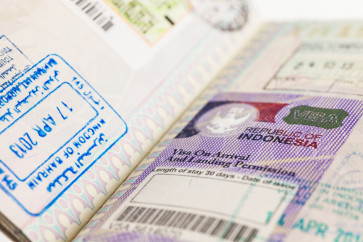Popular Reads
Top Results
Can't find what you're looking for?
View all search resultsPopular Reads
Top Results
Can't find what you're looking for?
View all search resultsOptimizing Indonesia’s dual engine of economic growth
This is not about finding the right economic sector, but how human capital quality can be improved to increase productivity and how structural reforms can generate a supportive business environment.
Change text size
Gift Premium Articles
to Anyone
B
efore the pandemic affected the Indonesian economy in the second quarter of 2020, the quality of its economic growth was evident. An indicator such as open unemployment decreased, showing that Indonesia's actual economic growth was higher than its minimum economic growth to create jobs. At the time, Indonesia's inflation rate was showing market optimism, with actual inflation higher than the expected inflation.
Besides, both indicators of income inequality and poverty rates were also declining. Public policy-wise, in addition to its large investments in infrastructure, Indonesia's focus has been on the endogenous factor, its human capital. Indonesia acknowledged that investing in human capital through education and health policies is key to development. It acknowledged that the economic transformation it is creating would not proceed optimally without developing human capital.
Nevertheless, in early 2020, a global virus outbreak turned strong economic performances upside down, including in Indonesia. The pandemic put the endogenous growth of development and human capita at very high risk.
According to Statistics Indonesia’s (BPS) latest macroeconomic data released on Nov. 5, the Indonesian economy did better in this third quarter than in the second. This reflects the significant government efforts to speed up budget spending to cushion the pandemic's impact on the economy.
Besides, it also shows Indonesia’s economic resilience and agility. The first is because the growth of major sources of the manufacturing sector, household spending, and Java Island in the third quarter improved over the second quarter. The latter because the total economic growth remains better than those of major sources of economic growth. Indonesia's minor economic growth sources have been experiencing product diversification to compensate for its major economic growth sources.
There is dual-engine economic growth in all countries, including Indonesia, which any country can optimize as we head for 2021. The first engines is consumer spending and government expenditure, while the second engine is investment and net export. To keep its saving rate, both engines work concurrently. If the first engine accelerates, then the second engine needs to be accelerating too.
In Indonesia's first engine of growth, consumer spending plays a major role. Its contribution to the Indonesian economy is around 59 percent of the gross domestic product (GDP). Household spending of basic needs is also the core of Indonesia's aggregate demand. The pandemic has decreased aggregate demand as seen in the consistent decline of the inflation rate from 2.96 percent in March to 1.42 percent in September 2020.
Therefore, the key to jump-starting the economy lies in the effectiveness of stimulating essential consumer spending. This is affected by two factors: first, the containment of the pandemic and second, the marketability to cure itself using the help of the digital economy. The latter has helped sustain economic activities amid curbs to public activity.
From its second engine of growth, Indonesia, as a developing country, has a current account deficit due to its saving-investment gap. This gap is covered by both the short-run derivative and long-run direct investments.
During the increasing global prices of primary products in 2008-2011, Indonesia had a current account surplus. Yet, as international commodity prices declined, Indonesia returned to a current account deficit. An essential factor in optimizing the second engine is to connect investment with net exports. To achieve this, Indonesia needs to improve its competitiveness and intensively connect its manufacturing and service sector networks to global value chains.
My investment and net export model entitled V-Composite Index shows that the Indonesian economy is mostly integrated to ASEAN and non-ASEAN members, such as China, Japan, the United States, India, South Korea, Netherlands, and Australia. Some of these non-ASEAN members are already connected, either throughout the regional plus frameworks, such as the ASEAN Plus Free Trade Area (ASEAN+FTA), the Regional Comprehensive Economic Partnership (RCEP), or via comprehensive bilateral economic agreement, such as the Comprehensive Economic Partnership Agreement (CEPA).
As a net investment recipient country and with the need to improve its trade competitiveness, Indonesia must maintain its strong economic relations with investment origin countries such as those mentioned above. These economic ties must be established under mutual interests and sustained by a win-win principle.
During this global pandemic, it seems that every country attempts to maintain its economic multiplier domestically. Indonesia is also keen to increase its domestic supply over imported products. Yet, the increasing household spending through the digital economy and stimulation may increase imports.
From the digital economy side, Indonesia's products must compete with imported ones to meet domestic market demand. Meanwhile, from the policy side, one of the methods that can soften the impact of imports is countertrade. This has six types of models, and the one most frequently used is the counter purchase, where one country does trade with another without using its international reserves.
For instance, there are two countries involved: country A and country B. This agreement works when country A buys country B's products only if country B buys country A's products. This agreement will increase the trade flows of final and derived demand products and simultaneously save the international reserves.
In sum, any country can be turning its economy back to the previous time by optimizing its double-engine of economic growth with two conditions. The necessary condition remains on how the pandemic is contained. Simultaneously, sufficient conditions consist of using this time as the right time to apply structural reforms and increase labor productivity.
This is not about finding the right economic sector, but how human capital quality can be improved to increase productivity and how structural reforms can generate a supportive business environment.
There are at least three sufficient conditions to complement the necessary condition mentioned above: a reliable set of institutions, a good regulatory framework, and a higher quality of human capital. Both necessary and sufficient conditions are fundamentals for both engines of economic growth to work optimally.
***
The writer is special adviser on industry and international trade to the finance minister and lecturer at the School of Economics and Business at the University of Indonesia. The views expressed here are his own.










